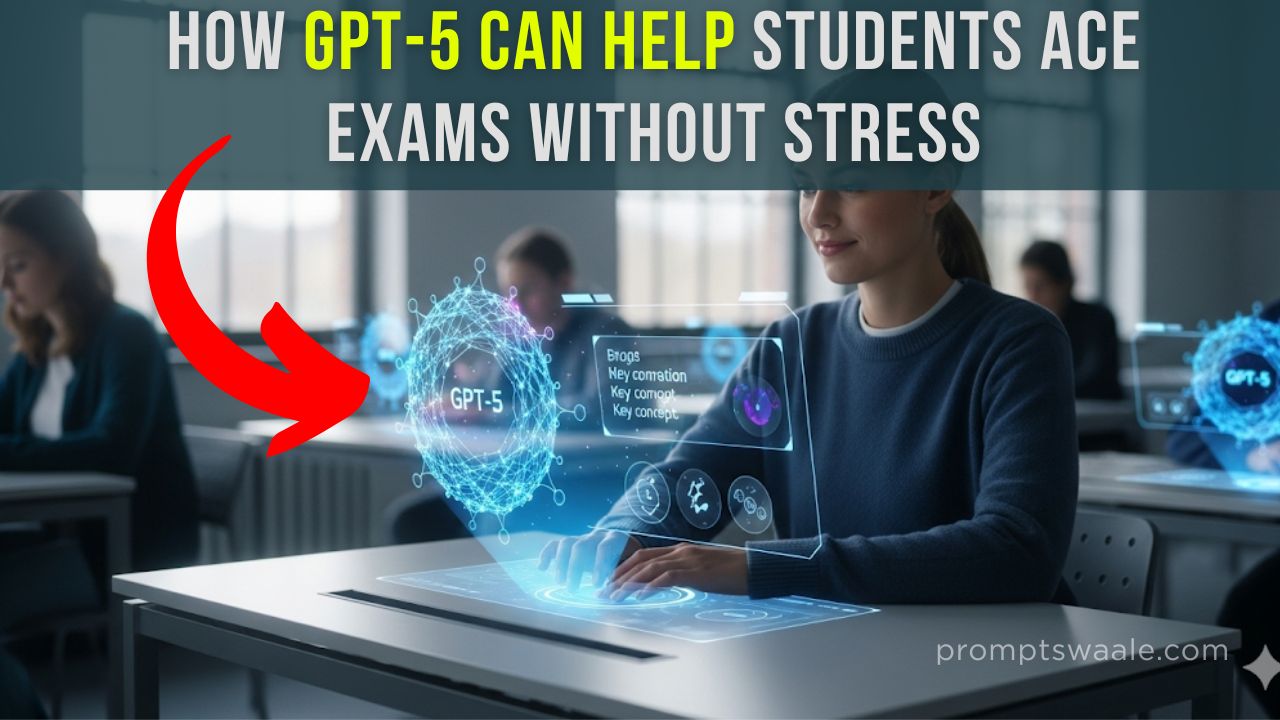
In today’s fast-paced academic world, students face increasing pressure to perform exceptionally in exams. The combination of dense curricula, tight deadlines, and competitive environments can result in significant stress. Fortunately, advancements in artificial intelligence (AI), particularly the development of GPT-5, offer transformative solutions to optimize study strategies, improve comprehension, and enhance exam performance while minimizing stress. This article explores the myriad ways GPT-5 can empower students to excel academically through smart, personalized, and efficient learning.
Understanding GPT-5 and Its Capabilities
GPT-5, the latest iteration of OpenAI’s generative pre-trained transformer models, represents a monumental leap in natural language processing. Unlike earlier versions, GPT-5 excels in:
- Deep contextual understanding: It comprehends complex concepts, long passages, and nuanced instructions.
- Personalized guidance: It can tailor explanations and strategies according to a student’s unique learning style.
- Interactive problem-solving: Students can engage in dynamic Q&A sessions to clarify doubts instantly.
- Content generation: GPT-5 can create comprehensive study notes, summaries, and practice questions aligned with exam syllabi.

By integrating GPT-5 into their study routines, students can transform passive learning into active, focused, and highly efficient study sessions, drastically reducing exam-related anxiety.
Personalized Study Plans Using GPT-5
One of the most significant stressors for students is the lack of an organized study strategy. GPT-5 can craft highly individualized study plans based on:
- Subject proficiency: GPT-5 evaluates a student’s strengths and weaknesses in various topics.
- Time availability: It designs study schedules that maximize learning while respecting time constraints.
- Exam patterns: By analyzing past question papers, GPT-5 prioritizes high-probability topics and patterns.
- Learning preferences: Whether a student prefers visual aids, summaries, or practice problems, GPT-5 adapts its outputs accordingly.

For example, a student preparing for a physics exam can receive a detailed daily schedule that balances concept revision, problem-solving, and timed mock tests, ensuring thorough preparation without feeling overwhelmed.
Efficient Note-Making and Summarization
Manual note-taking can be both time-consuming and inefficient, especially when dealing with voluminous textbooks and reference materials. GPT-5 excels in automatic summarization, condensing large amounts of information into concise, digestible notes. Key features include:
- Highlighting core concepts: GPT-5 identifies essential theories, formulas, and definitions for quick revision.
- Creating structured outlines: Notes are formatted logically, with headings, subheadings, and bullet points for clarity.
- Custom flashcards: GPT-5 can generate digital flashcards for active recall, one of the most effective memory techniques.
- Adaptive summaries: Depending on difficulty level, GPT-5 can produce beginner-friendly or advanced summaries, suitable for quick review sessions or deep dives.
With these features, students can save hours of manual work, focusing their energy on understanding and applying concepts rather than rote memorization.
Interactive Learning and Doubt Resolution
A major source of exam stress is unresolved doubts. GPT-5 serves as an on-demand tutor, offering immediate explanations that are clear, detailed, and tailored to the student’s level of understanding. Benefits include:
- Step-by-step problem solving: GPT-5 breaks down complex problems into manageable steps, allowing students to follow logically.
- Concept reinforcement: By explaining concepts in multiple ways, GPT-5 ensures deeper understanding and retention.
- Real-time feedback: Students can check their answers and receive corrections instantly, which is crucial for self-paced learning.
- Scenario-based questions: GPT-5 can create hypothetical scenarios to test application skills, especially in subjects like economics, biology, or social sciences.
This interaction reduces dependency on traditional tutoring, alleviates frustration from unanswered questions, and builds confidence before exams.
Exam Simulation and Practice
Effective exam preparation requires more than passive reading; it relies on consistent, realistic practice. GPT-5 transforms study routines by creating customized question banks aligned with the syllabus and difficulty level, allowing students to access hundreds of targeted practice questions. Its ability to generate timed mock tests replicates real exam conditions, helping students build stamina, maintain focus, and improve time management. GPT-5 also offers immediate scoring and detailed performance analysis, highlighting weak areas and recommending focused revisions.
Furthermore, it supports a variety of question types, including multiple-choice, descriptive, numerical, and case-based questions, ensuring comprehensive preparation. Regular engagement with GPT-5-generated tests enables students to internalize exam patterns, enhance problem-solving efficiency, and reduce anxiety by familiarizing themselves with exam scenarios. This dynamic, interactive approach equips learners with the confidence, practice, and strategic insight necessary to excel under pressure.
Stress Reduction Through Smart Study Techniques
Stress often stems from poor planning, overwhelming content, and fear of failure. GPT-5 addresses these issues by promoting evidence-based learning strategies, including:
- Spaced repetition: GPT-5 schedules topic reviews at optimal intervals to enhance long-term retention.
- Interleaving practice: By mixing different subjects or topics, it prevents monotony and strengthens cognitive connections.
- Active recall: GPT-5 encourages recalling information without looking at notes, a proven method for deep learning.
- Mind maps and visual aids: For visual learners, GPT-5 can convert textual information into diagrams, flowcharts, and infographics, simplifying complex subjects.

By integrating these methods into daily study routines, students can retain more knowledge efficiently and maintain a calm, focused mindset.
Language and Writing Assistance
Many students struggle with essay-type questions, report writing, or comprehension-based answers. GPT-5 assists by:
Structuring Essays: GPT-5 creates detailed essay frameworks, including logical outlines, compelling introductions, well-organized body paragraphs, and strong conclusions, ensuring responses are coherent and impactful.
Enhancing Vocabulary: It suggests precise synonyms, advanced terminology, and context-appropriate phrases, elevating the overall quality and sophistication of written answers.
Proofreading and Editing: GPT-5 meticulously checks spelling, grammar, punctuation, and sentence flow, ensuring clarity, readability, and professional presentation. It also identifies awkward phrasing and improves coherence across paragraphs.
Exam-Oriented Writing: GPT-5 tailors content according to exam-specific requirements, whether descriptive, analytical, argumentative, or case-based, helping students align their responses with expected academic standards.
Time Efficiency: By providing ready-to-use writing frameworks and refined content, GPT-5 saves valuable exam preparation time, allowing students to focus on understanding concepts and practicing application.
Confidence Building: Consistent use of GPT-5 for writing practice reduces anxiety, as students gain clarity on how to structure and articulate their thoughts effectively under timed conditions.
Comprehensive Support: From brainstorming ideas to delivering polished, high-quality answers, GPT-5 ensures students are fully prepared for all written exam formats.
Accessible Learning Anytime, Anywhere
Multi-Device Access: GPT-5 can be accessed seamlessly via desktop computers, tablets, and mobile devices, allowing students to continue learning from virtually anywhere, whether at home, on the commute, or in a quiet outdoor space.
Remote Learning: With GPT-5, students no longer rely on physical libraries, textbooks, or tutors, as the AI provides comprehensive explanations, notes, and practice materials instantly, making learning fully self-sufficient.
Flexible Scheduling: Students can engage with GPT-5 outside traditional school hours, integrating study sessions into personal routines without disrupting other responsibilities. This flexibility supports consistent learning habits and maximizes productivity.
Real-Time Updates: GPT-5 ensures that content is always aligned with updated syllabi, exam patterns, and emerging academic standards, helping students stay current without manual research.
Personalized Study Environments: AI adapts to individual learning pace and style, providing targeted content for rapid understanding, whether through interactive Q&A, summaries, or practice exercises.
Stress Reduction: Continuous, flexible access reduces last-minute cramming and study-related anxiety, enabling students to maintain mental well-being while staying academically prepared.
Enhanced Performance: By combining accessibility, adaptability, and instant content delivery, GPT-5 empowers students to maintain discipline, optimize learning efficiency, and achieve top performance under any circumstances.

This flexibility ensures students maintain consistent study habits, a critical factor in achieving high performance while avoiding burnout.
Tailored Motivation and Psychological Support
Exam preparation is not just academic; mental resilience plays a crucial role. GPT-5 can support students psychologically by:
- Providing motivational guidance: Encouraging messages and goal-setting techniques help maintain focus.
- Tracking progress: Visual dashboards show improvements over time, reinforcing a sense of achievement.
- Mindfulness prompts: Suggestions for short breaks, relaxation exercises, and focus techniques enhance cognitive efficiency.
- Stress monitoring: GPT-5 can detect study fatigue patterns and recommend adjustments to prevent burnout.
By combining academic support with motivational guidance, GPT-5 fosters holistic exam readiness, balancing knowledge acquisition with mental well-being.
Integrating GPT-5 With Collaborative Learning
Shared AI-Generated Notes: Students can distribute GPT-5-generated summaries, study guides, and key concept notes among peers, facilitating informed discussions and promoting a collective understanding of complex topics.
Moderating Group Sessions: GPT-5 can organize and guide group study sessions, setting agendas, dividing topics efficiently, and ensuring that collaboration remains structured and productive, reducing wasted time.
Interactive Quizzes and Challenges: The AI can create group quizzes, flashcards, and problem-solving challenges, encouraging active participation and reinforcing knowledge through collective learning exercises.
Consistent Peer Feedback: GPT-5 assists in evaluating group responses and providing constructive feedback, helping students identify areas for improvement and fostering a supportive learning environment.
Enhanced Collaboration: By integrating AI insights with human discussion, GPT-5 ensures balanced contribution from all group members, reducing dominance by a few and encouraging equal engagement.
Anxiety Reduction: Collaborative learning supported by GPT-5 minimizes the stress of studying alone, as students gain clarity, motivation, and confidence through peer interaction coupled with AI guidance.
Comprehensive Learning Ecosystem: This approach combines artificial intelligence with human interaction, creating a dynamic, enriching, and highly effective study ecosystem that maximizes both knowledge retention and interpersonal learning skills.
Conclusion: Redefining Exam Preparation With GPT-5
GPT-5 is more than an AI tool; it represents a revolution in student learning and exam preparation. By offering personalized study plans, efficient note-making, interactive doubt resolution, exam simulation, and stress management techniques, GPT-5 empowers students to excel academically without the traditional stressors associated with exams. Its versatility, accessibility, and adaptability ensure that learners not only retain knowledge effectively but also cultivate confidence, mental resilience, and a strategic approach to examinations.
By integrating GPT-5 into their study routines, students can transition from reactive and stressful preparation to proactive, intelligent, and calm learning, setting the stage for success in any academic challenge.
